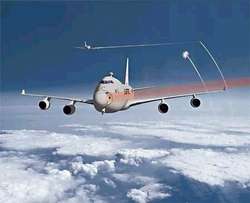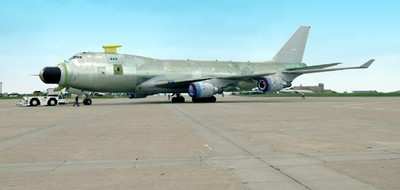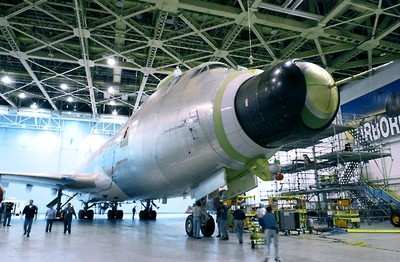Weapon Actively Tracks Airborne Targets, Fires Surrogate
High-Energy Laser
 The Boeing Company
successfully completed a key Airborne Laser (ABL) flight test
Friday, demonstrating the weapon system's ability to actively track
an airborne target, compensate for atmospheric turbulence and fire
a surrogate for its missile-killing high-energy laser.
The Boeing Company
successfully completed a key Airborne Laser (ABL) flight test
Friday, demonstrating the weapon system's ability to actively track
an airborne target, compensate for atmospheric turbulence and fire
a surrogate for its missile-killing high-energy laser.
During the test, the modified Boeing 747-400F took off from
California's Edwards Air Force Base and used its infrared sensors
and its track illuminator laser (TILL) to find and track an
instrumented target board located on the US Air Force's NC-135E Big
Crow test aircraft, according to Boeing.
The Big Crow then fired its beacon laser at the ABL aircraft to
allow ABL to measure and compensate for laser beam distortion
caused by the atmosphere. Finally, ABL fired the surrogate
high-energy laser (SHEL) at the Big Crow target board to simulate a
missile shootdown. With the exception of ABL's beacon illuminator
laser (BILL), this flight test demonstrated the entire engagement
sequence from target acquisition to pointing and firing the
SHEL.
"This successful test shows that ABL can find and track a
target, use its beam control/fire control system to compensate for
atmospheric turbulence, and fire a surrogate high-energy laser to
simulate a missile intercept," said Pat Shanahan, vice president
and general manager of Boeing Missile Defense Systems. "We have now
demonstrated most of the steps needed for the Airborne Laser to
engage a threat missile and deliver precise and lethal effects
against it."
ABL fired the TILL at the Big Crow target board for the first
time March 15; as ANN reported, the aircraft
arrived at Edwards in June. This latest test demonstrated ABL's
ability to transition from passive tracking of a simulated missile
plume to active tracking, by "walking" the TILL beam to the nose of
the missile and using the TILL light returning from the edge of
missile for precision tracking and determination of where to point
the SHEL on the target. In addition, atmospheric turbulence
compensation was performed concurrent with active tracking and SHEL
firing.

In upcoming flight tests, ABL will again demonstrate the
engagement sequence, but this time use the return from its BILL
instead of the Big Crow's beacon laser to measure atmospheric
distortion. After these flight tests, the program will install the
actual Northrop Grumman-built high-energy laser in the aircraft to
prepare for the first intercept test against an in-flight ballistic
missile in 2009, according to the company.
The high-power chemical laser has completed rigorous ground
testing at Edwards Air Force Base and is being prepared for
installation.
Boeing is the prime contractor for ABL, which will provide a
speed-of-light capability to destroy all classes of ballistic
missiles in their boost phase of flight. Boeing provides the
modified aircraft and the battle management system and is the
overall systems integrator.

ABL partners are Northrop Grumman which supplies the high-energy
laser and the beacon illuminator laser, and Lockheed Martin, which
provides the nose-mounted turret and the beam control/fire control
system.
 ANN's Daily Aero-Linx (05.02.24)
ANN's Daily Aero-Linx (05.02.24) ANN's Daily Aero-Term (05.02.24): Touchdown Zone Lighting
ANN's Daily Aero-Term (05.02.24): Touchdown Zone Lighting Aero-News: Quote of the Day (05.02.24)
Aero-News: Quote of the Day (05.02.24) ANN FAQ: Contributing To Aero-TV
ANN FAQ: Contributing To Aero-TV NTSB Final Report: Cirrus Design Corp SR20
NTSB Final Report: Cirrus Design Corp SR20





